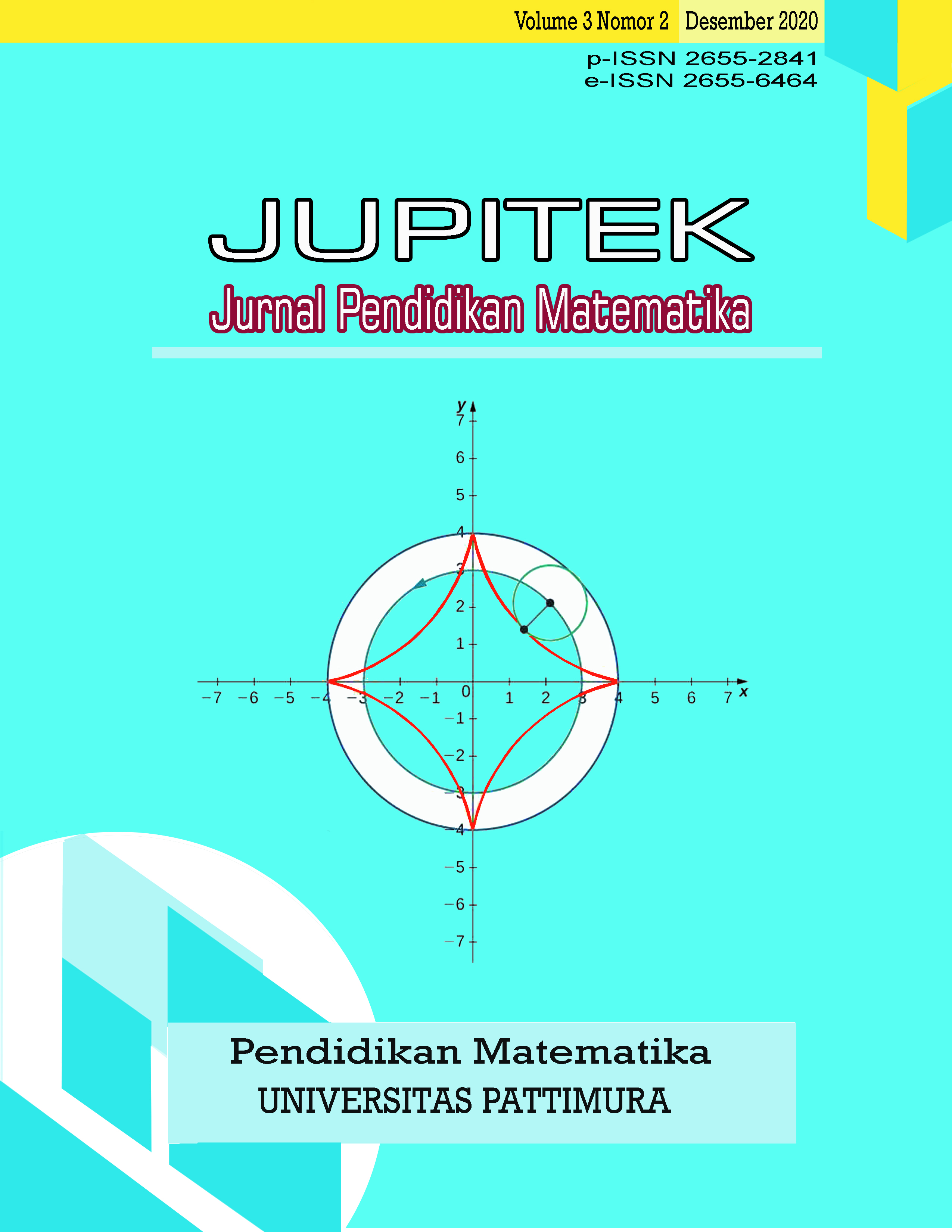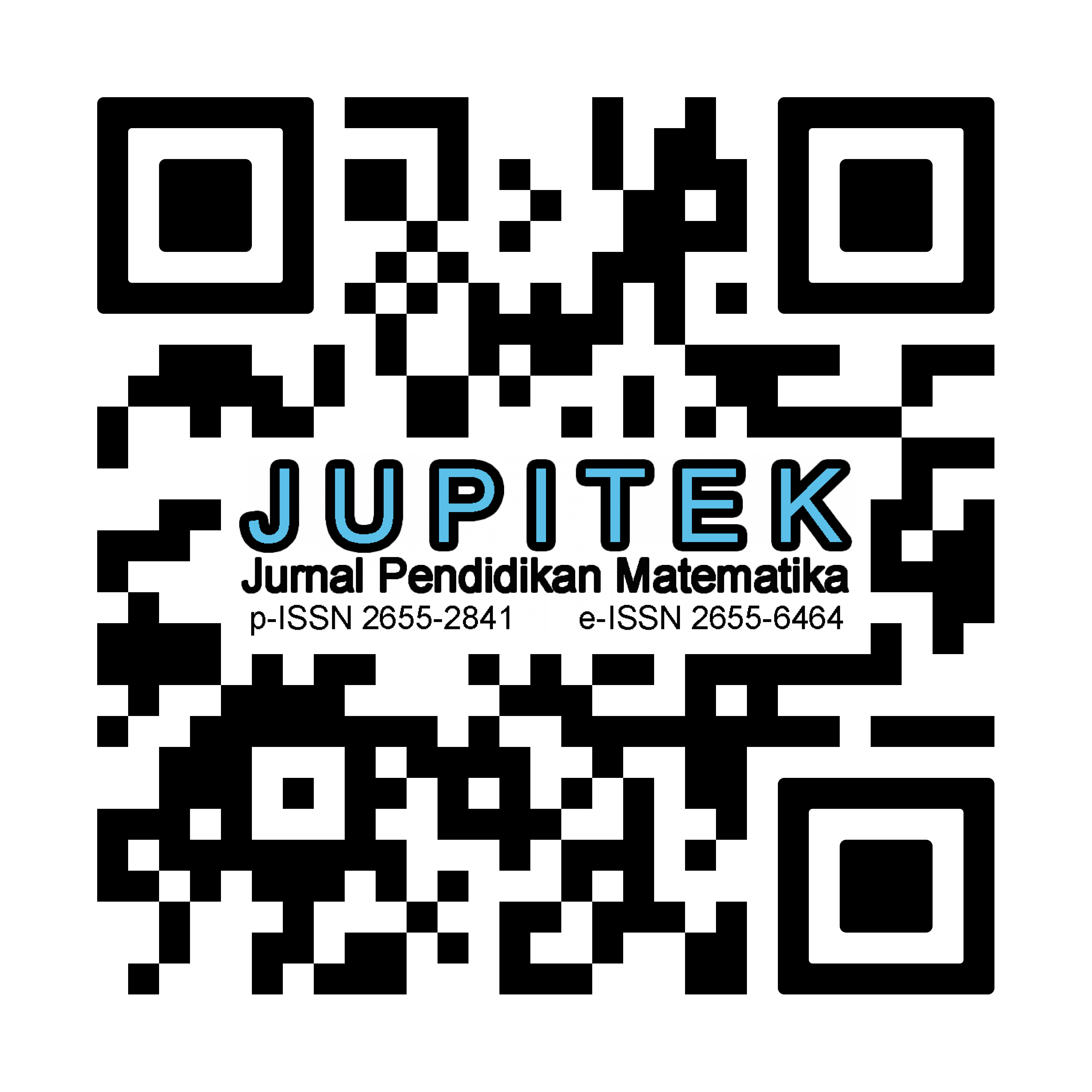PENGEMBANGAN VIDEO PEMBELAJARAN FUNGSI KOMPOSISI SEBAGAI ALTERNATIF BAHAN AJAR UNTUK MENINGKATKAN KEMAMPUAN PENALARAN MATEMATIS
Abstract
Penelitian ini bertujuan untuk menghasilkan video pembelajaran pada materi fungsi komposisi sebagai alternative bahan ajar dan untuk mengetahui kelayakan video pembelajaran tersebut ditinjau dari presentase kevalidan oleh validator dan guru matematika, serta respon dan hasil tes siswa terhadap video pembelajaran fungsi komposisi yang dikembangkan. Metode penelitian menggunakan metode penelitian dan pengembangan atau Research and Development. Dengan langkah-langkah pengembangan diantaranya: (1) perencanaan (2) desain; dan (3) pengembangan. Subjek penelitian yang digunakan adalah beberapa siswa dalam kelompok kecil di Madrasah Aliyah Hasyim Ay’ari Bangsri Jepara. Hasil penelitian menunjukkan bahwa: (1) video pembelajaran pada materi fungsi komposisi sebagai alternatif bahan ajar; (2) video pembelajaran fungsi komposisi mendapatkan penilaian kelayakan berdasarkan dosen ahli dan guru matematika diperoleh hasil “Sangat Valid†dengan presentase rerata penilailan 82,4% dari aspek materi, diperoleh hasil “Sangat Valid†dengan presentase rerata penilaian 87,2% dari aspek media, berdasarkan penilaian oleh siswa didapat respon siswa yang “Positif†dengan presentase rerata penilaian 70%, dan hasil tes siswa dalam kelompok kecil mendapatkan rerata perolehan skor 69,6 yang masuk dalam kategori “Baikâ€. Menunjukkan bahwa video pembelajaran fungsi komposisi sebagai alternatif bahan ajar dengan kemampuan penalaran layak digunakan dalam proses pembelajaran oleh guru dan siswa di SMA/MA
Downloads
References
Akbar, R. R. A., & Komarudin, K. (2018). Pengembangan Video Pembelajaran Matematika Berbantuan Media Sosial Instagram sebagai Alternatif Pembelajaran. Desimal: Jurnal Matematika, 1(2), 209. https://doi.org/10.24042/djm.v1i2.2343
Alessi, S. ., & Trollip, S. (2001). Multimedia for learning: mehods and development (3rd Edition) (3rd ed.). Allyn and Bacon.
Apriansyah, M. F., & Pujiastuti, H. (2020). Pengembangan Bahan Ajar Matematika berbasis Virtual Learning dengan Gnomio. Jurnal Pendidikan Matematika, 11(2), 179–188. https://doi.org/http://dx.doi.org/10.36709/jpm.v11i2.11921
Arfianto, H., & Hakim, D. L. (2019). Penalaran Matematis Siswa Pada Materi Fungsi. Prosiding Seminar Nasional Matematika Dan Pendidikan Matematik Sesiomadika 2019, 2018, 1248–1256.
Basir, M. A. (2015). Masalah Matematis Ditinjau Dari Gaya Kognitif. Jurnal Pendidikan Matematika FKIP Unissula, 3(1), 106–114.
Damayanti et.al. (2018). Kelayakan Media Pembelajaran Fisika Berupa Buku Saku Android pada Materi Fluida Statis. Indonesian Journal of Science and Matematics Education, 1(1), 63–70.
Fuadi, R., Johar, R., & Munzir, S. (2016). Peningkatkan Kemampuan Pemahaman dan Penalaran Matematis melalui Pendekatan Kontekstual. Jurnal Didaktik Matematika, 3(1), 47–54. https://doi.org/10.24815/jdm.v3i1.4305
Kusumawati, E., & Aulia, F. (2018). Identifikasi Kesulitan Menyelesaikan Soal Fungsi Komposisi Peserta Didik Kelas X Keuangan Smk Negeri Di Banjarmasin Tahun Pelajaran 2016/2017. EDU-MAT: Jurnal Pendidikan Matematika, 5(2), 150–161. https://doi.org/10.20527/edumat.v5i2.4639
Lopes, A. P., & Soares, F. (2016). Video Lectures and Online Activities To Engage Students in a Flipped Classroom. EDULEARN16 Proceedings, 1(July), 8688–8695. https://doi.org/10.21125/edulearn.2016.0890
Muslimin, & Sunardi. (2019). Analisis Kemampuan Penalaran Matematika Siswa SMA pada Materi Geometri Ruang. KREANO : Jurnal Matematika Kreatif Dan Inovatif, 10(2), 171–178. https://doi.org/https://doi.org/10.15294/kreano.v10i2.18323
Perlman, S. (2020). Another Decade, Another Coronavirus. New England Journal of Medicine, 382(8), 758–760. https://doi.org/10.1056/NEJMe1917479
Purwanto, Y., & Rizki, S. (2015). Pengembangan Bahan Ajar Berbasis Kontekstual Pada Materi Himpunan Berbantu Video Pembelajaran. AKSIOMA Journal of Mathematics Education, 4(1), 67–77. https://doi.org/10.24127/ajpm.v4i1.95
Rifai, A. S. (2016). Analisis kesulitan siswa belajar matematika pada pokok bahasan komposisi fungsi dan invers fungsi kelas xi sma negeri 8 bulukumba kabupaten bulukumba. http://repositori.uin-alauddin.ac.id/11324/1/SKRIPSI ANDI SYAMSUL RIFAI.pdf
Susanti, B., & Lestari, Y. A. P. (2019). Analisis Kesulitan Siswa Kelas XI dalam Menyelesaikan Soal Fungsi Komposisi Dan Fungsi Invers di SMK AL-IKHSAN Batujajar. Journal on Education, 01(03), 446–459. http://www.jonedu.org/index.php/joe/article/view/189/158
Thomas, C. (1997). The composite function rule ( the chain rule ) [University of Sidney]. In Mathematics Learning Centre. https://www.sydney.edu.au/content/dam/students/documents/mathematics-learning-centre/composite-functions-and-derivatives.pdf
Utami, A. S. (2017). Analisis kesalahan siswa dalam menyelesaikan soal cerita pokok bahasan komposisi fungsi di SMK Bakti Purwokerto. Journal of Mathematics Education, 3(2), 48–56.
Wardoyo, T. C. T., & Faqih Ma’arif, M. (2015). Pengembangan Media Pembelajaran Berbasis Video Animasi Pada Mata Pelajaran Mekanika Teknik Di SMK Negeri 1 Purworejo. E-Journal Pend. Teknik Sipil Dan Perencanaan, 3(3), 1. http://journal.student.uny.ac.id/ojs/index.php/sipil/article/view/4171
Weeraratne, B., & Chin, B. (2018). Can Khan Academy e-Learning Video Tutorials Improve Mathematics Achievement in Sri Lanka?. International Journal of Education and Development Using Information and Communication Technology, 14(3), 93–112.
Yahya, A., & Bakri, N. W. (2017). Penerapan Model Kooperatif Student Teams Achievement Divisions untuk Meningkatkan Hasil Belajar Siswa. JURNAL SAINTIFIK, 3(2), 171–181. https://doi.org/10.26675/jabe.v1i4.6035
Copyright (c) 2020 Ainia Rahmayanti, Mochamad Abdul Basir, Dyana Wijayanti

This work is licensed under a Creative Commons Attribution-NonCommercial-ShareAlike 4.0 International License.
License and Copyright Agreement
By submitting a manuscript to Jurnal Pendidikan Matematika (JUPITEK), the author(s) certify and agree to the following terms:
- Originality and Authority: The submitting author is authorized by all co-authors to enter into this agreement. The manuscript describes original work that has not been published previously in a peer-reviewed journal, nor is it under consideration for publication elsewhere.
- Approval: Its publication has been approved by all author(s) and by the responsible authorities of the institutions where the work was carried out.
- Rights: The authors secure the right to reproduce any material that has already been published or copyrighted elsewhere.
- Licensing and Copyright: Authors retain the copyright to their work.
- License Grant: The authors grant Jurnal Pendidikan Matematika (JUPITEK) the right of first publication, with the work simultaneously licensed under the Creative Commons Attribution-NonCommercial-ShareAlike 4.0 International (CC BY-NC-SA 4.0).
- Self-Archiving: Authors are permitted and encouraged to deposit the published version of their article in institutional repositories, on their personal websites, and other academic platforms, with proper acknowledgment of its initial publication in Jurnal Pendidikan Matematika (JUPITEK).






.png)


